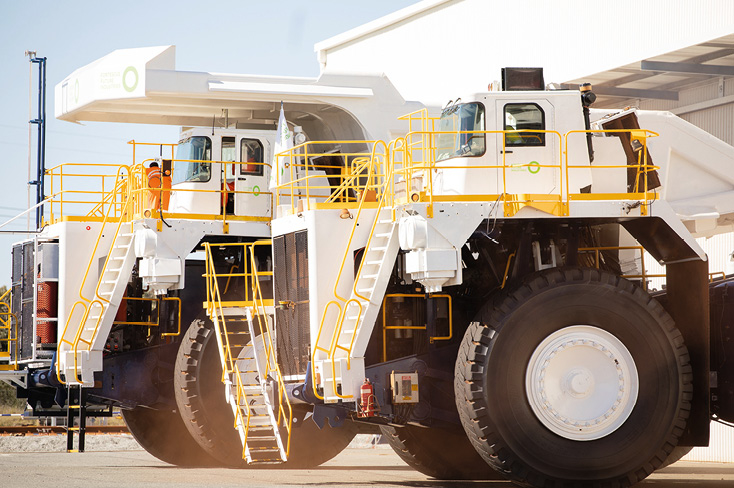https://www.pv-magazine.com/2022/12/03/weekend-read-shining-magnate/
Weekend read: Shining magnate

Fortescue Future Industries has developed green hydrogen haul trucks to replace diesel vehicles for its mining operations.
Photo: Fortescue Future Industries
For some, the notion of clean mining is a contradiction in terms. New research from the Technical University of Berlin, published in the “Journal of Cleaner Production,” found that the environmental costs of the mining sector amount to as much as $5 trillion annually, with most of the damage attributed to greenhouse gases emitted in the excavation of coal and iron ore.
But while the mining industry has long been a laggard in all things sustainable and environmental, the sector is beginning to take up a new mantle as a crucial part of the transition to renewable energy sources.
Rebecca Campbell, global head of mining and metals for law firm White & Case, has argued that previously “the mineral commodities cycle has been out of synchronization with the global macroeconomic cycle,” but “this time the cycles appear to be converging.” However, a recent report from the law firm warned that “softening commodity prices and economic headwinds may deter miners and metal companies from deploying the significant capital expenditure required to decarbonize.”
This fear is shared by Duncan Wanblad, chief executive of miner Anglo American who, in July 2022, said higher borrowing costs and political instability due to inflation were threatening to delay billions of dollars of investment into mining decarbonization.
However, the September 2022 announcement of Fortescue Metals Group’s fully funded, $6.2 billion plan to decarbonize by 2030 presents a wholly different narrative. Fortescue chairman Andrew Forrest announced the plan at the United Nations general assembly as part of US president Joe Biden’s “First Movers Coalition.”
Mark Hutchinson, the CEO of Fortescue’s green energy arm, Fortescue Future Industries (FFI), tells pv magazine the company’s plan demonstrates that if one of the world’s biggest iron ore miners can embark on such an ambitious decarbonization target, anybody can. And what is more, far from balking at the price tag of decarbonization in the midst of inflation, as his Anglo American counterpart appears to have done, Hutchinson believes the numbers are on his side.
Decarbonizing mining
In much the same way that Roger Bannister showed the world a mile could be run in under four minutes, Hutchinson tells pv magazine that since the decarbonization announcement, there has been an amazing response from other companies realizing that if a mining company can achieve that goal, then anyone can.
This should come as no surprise, considering the recent findings of an Ernst & Young (EY) survey of global mining leaders. The survey found environmental, social, and corporate governance (ESG) issues; geopolitics; and climate change were the top three risks and opportunities facing mining and metals companies over the next year.
EY’s global mining and metals leader, Paul Mitchell, said that while managing ESG risk is becoming more complex, “miners who get it right can get an edge on competitors in many ways – from accessing capital, to securing licenses to operate, attracting talent, and mitigating climate risk.”
Fortescue claims its multi billion-dollar investment will see the avoidance of the equivalent of 3 million tons of CO2 emissions per annum and provide cost savings of $818 million yearly from 2030, thanks to savings on diesel, gas, and carbon credits. Fortescue estimates it will have paid back its capital investment by 2034 while simultaneously de-risking the company’s operating cost profile and establishing new opportunities through the production of carbon free iron ore.
“It proves to the world that we’re real [about decarbonization], that we’re taking a mining company (and normally mining companies are the laggards) and showing that it can be done,” says Hutchinson.
He is the first to admit the $6.2 billion decarbonization strategy is ambitious but, considering the company expects to save $3 billion in fuel costs alone before 2030, fortune may well favor the brave.
“The big learning for us was that companies get easily stuck in the mindset where fuel costs are fixed,” Hutchinson says. “But if we look at our fuel spending for, say, the next 10 years, and use that money for capital costs instead, we’ll save that money forever. And we realized that not only could you decarbonize but you could make money. We spend over a billion dollars a year on just diesel alone but from 2030 we don’t pay any fuel costs at all, we own the house.”
Not only does decarbonization de-risk the company, adds Hutchinson, it also gives it continued access to capital markets which are now shifting toward a greener end of the spectrum. This is no small benefit. After all, consulting firm McKinsey has estimated that the cost of capital can be 20% to 25% higher for miners with the lowest ESG scores.
Nevertheless, working out the numbers and making the plan work are two very different beasts. “It’s certainly not simple,” says Hutchinson about Fortescue’s pathway to net-zero emissions. “But solar is very helpful for us and we do already have some solar on our sites.”
Generation plans
Across Fortescue’s five major mine sites in Australia, it plans to install 2.5 GW of predominantly solar and wind generation capacity, shored up with significant amounts of energy storage. This storage may come in the form of batteries but, thanks to the natural elevation of the Pilbara region, Hutchinson says the company is also seriously considering pumped hydro.
However, due to current PV market conditions and alleged supply chain practices, Hutchinson tells pv magazine that while solar will play a part, the decarbonization strategy will rely heavily on wind in the short term. “Solar will be a big part but there is this issue which I think a lot of foreign companies have at the moment. Whereas China has 90% of the world’s PV, there are some issues in China that make it very difficult to buy, and also to finance as many financiers just won’t support PV coming out of China until you can do a proper audit and that’s not happening at the moment.”
Popular content
Hutchinson remains firmly committed to the idea the company would like to install more solar over time and is optimistic that PV manufacturing will burgeon in other parts of the world, such as India and the US. “Even if it’s more expensive, you’re not going to have a choice. You don’t want anywhere to own 90% of your supply chain for any product,” Hutchinson adds.
It should come as no surprise, then, that Fortescue Future Industries acquired a 60% stake in clean tech business High yield Energy Technologies Group (HyET) in 2021 and provided the finance for the expansion of HyET Solar’s photovoltaics factory in the Netherlands. The upstream solar investment won’t stop there, it seems.
“There’s not enough wind turbines made in the world, not enough solar, not enough electrolyzers,” continues Hutchinson. “We don’t want to get caught up in the supply chain but in PV particularly, there are some players around the world thinking differently, the United States in particular.”
The presence of subsidies in the US means Fortescue Future Industries “will absolutely manufacture PV in the US as well,” says Hutchinson. “We’ve learned a lot about security of supply from Covid-19, particularly about the benefits of manufacturing in-country.”
The larger message Hutchinson is keen to get across when it comes to decarbonization is that you can’t wait for anyone else to do it for you. “Don’t always rely on the OEMs” he says, referring to the original equipment manufacturers who supply kit to be branded further down the line. After long discussions with many OEMs, during which some of the earliest estimates for delivery of carbon-neutral vehicles to decarbonize Fortescue’s mining operations were in 2035, “we decided to do it ourselves,” says Hutchinson. “You have to take a much more aggressive view.”
To that end, FFI acquired Williams Advanced Engineering in January 2022. UK-based Williams, an offshoot of the successful Formula 1 motorsport team, is now providing Fortescue Future Industries with the kind of critical battery technology it needs to decarbonize its mining vehicles now, not in 2035.
Perhaps the most interesting product of the Williams acquisition will be Fortescue’s “Infinity Train,” which uses gravity braking to charge 70 MWh batteries on its 3.5 kilometer-long iron ore freight trains as they descend from the company’s Pilbara mine sites to the coast. These batteries, Hutchinson explained, then drive the train back up to the mine, to form a clean loop.
H2 Go
While Fortescue’s ambitious decarbonization announcement made headlines in September, the company and its outspoken chairman have for some time been garnering attention due to their ambitions in the green hydrogen sector.
In the past 18 months, the company has agreed to billions of dollars worth of supply deals for green hydrogen and its derivatives, including ammonia and synthetic methane. More recently, Fortescue has said it will double its green hydrogen spending as its push to replace natural gas in Europe accelerates. On Oct. 4, 2022, Fortescue partnered with Belgian green hydrogen startup Tree Energy Solutions to supply 300,000 metric tons of Australian green hydrogen to Europe via Tree’s planned import terminal in Wilhelmshaven, Germany.
“Germany has picked Australia for a reason,” says Hutchinson. “Getting gas from Russia hasn’t turned out so well and they realize now that security of supply is important.”
For Europe, green hydrogen can’t come quickly enough. But the passing of the Inflation Reduction Act (IRA) in the United States has turned the burgeoning green hydrogen sector on its head.
“What has happened in the US is amazing,” says Hutchinson. “Three dollars per kilogram for green hydrogen makes it competitive with gray hydrogen, now. Every investment dollar you have you should put in America … It’s ironic really, from being the laggards, now they’ve leapfrogged everyone.”
In more bad news for Europe, the US is unlikely to be an exporter of the green energy carrier, considering its domestic demand. “Europe is the place that really needs it,” says Hutchinson. “But it’s dithering around a bit. I really hope Europe can do something similar to what the Americans have done.”
Hutchinson likens the IRA policy package to the kind of seismic legislation which helped spur the PV market. “There were enormous government subsidies,” he recalls. “And you can include China as one giant subsidy, but that’s how they got the costs down. And this is going to be the same when we think about electrolyzers.”
Some armchair skeptics have declared Fortescue’s plans overly ambitious, though at this stage one wonders what the point of any ambition short of global decarbonization would be. For Hutchinson, it is the audacity of Fortescue’s plan and strategy that convinced him to join. And that “purely audacious” mindset, he says, “is what Andrew Forrest is.”
This content is protected by copyright and may not be reused. If you want to cooperate with us and would like to reuse some of our content, please contact: editors@pv-magazine.com.




